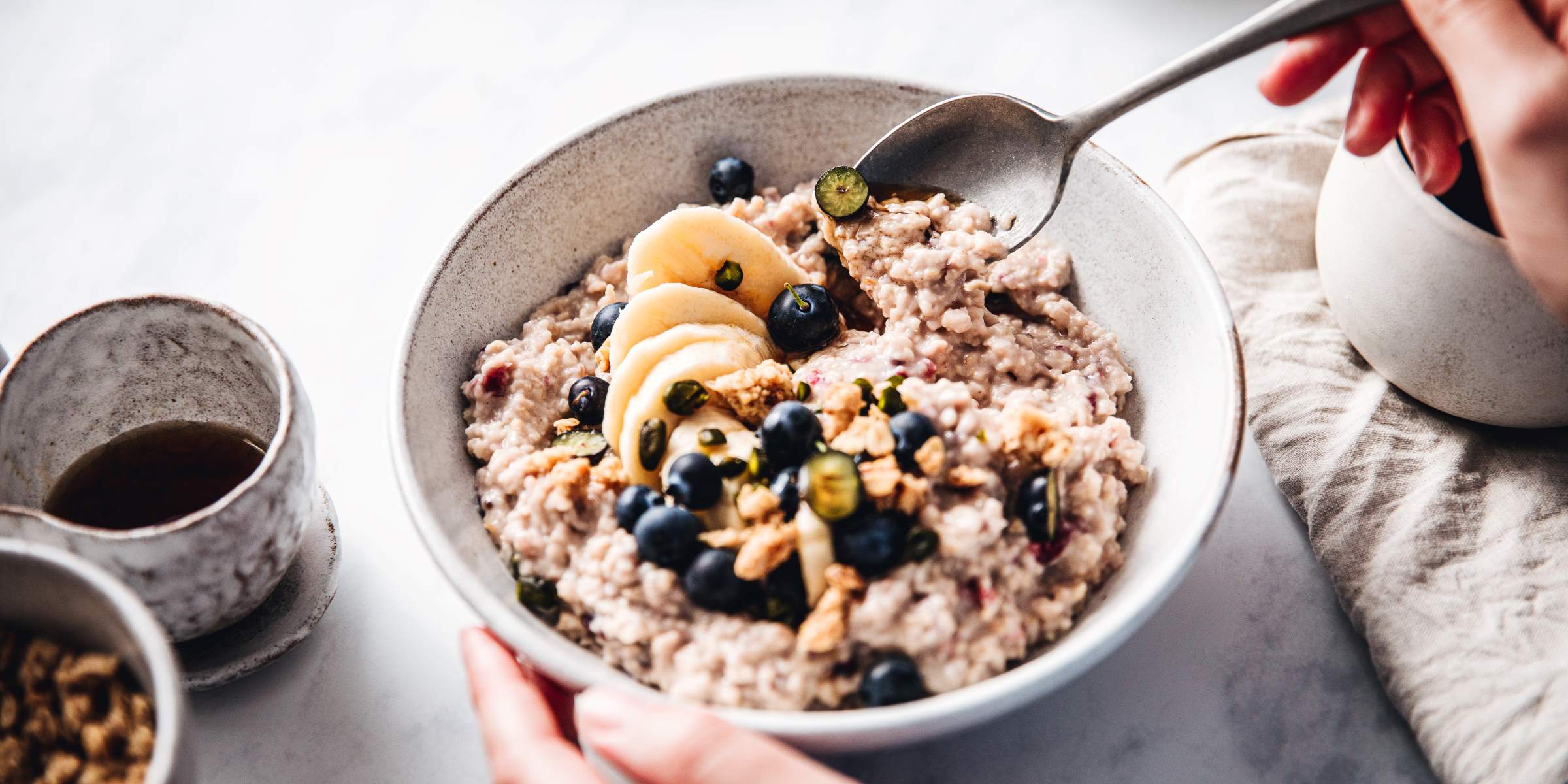Home>Misc>Featured>Which Of The Following Is The Best Example Of Increasing The Intensity Of A Workout?


Featured
Which Of The Following Is The Best Example Of Increasing The Intensity Of A Workout?
Modified: March 2, 2024
Discover the ultimate example of increasing workout intensity with our featured exercise! Find out how to push your limits and achieve better results.
Introduction
Welcome to the world of fitness and exercise! When it comes to working out, it’s important to continually challenge yourself and push your limits. Increasing the intensity of your workouts is a key aspect of progress and achieving your fitness goals. Whether you’re looking to build strength, increase endurance, or improve overall fitness, ramping up the intensity can help you take your workout to the next level.
Increasing the intensity of a workout involves various methods, such as increasing the duration, resistance, repetitions, or incorporating different training techniques. These methods not only provide a physical challenge but also keep your workouts exciting and prevent plateaus.
In this article, we’ll explore some of the best examples of increasing the intensity of a workout. From adjusting the duration and resistance to incorporating high-intensity interval training and utilizing circuit training, these strategies will help you break through fitness barriers and enhance your overall performance.
Remember, it’s important to listen to your body and gradually increase the intensity of your workouts. This will help to prevent injuries and allow for proper adaptation and recovery. Now, let’s dive into the various ways you can amp up your workouts and take your fitness journey to new heights!
Increase the Duration of the Workout
One of the simplest ways to increase the intensity of your workout is to increase its duration. By extending the length of your exercise session, you challenge your body to work harder and sustain the effort for a longer period of time.
If you’re currently doing a 30-minute workout, try adding an extra 5-10 minutes to your routine. This could mean adding an additional set of exercises or extending the duration of each exercise. Increasing the duration gradually allows your body to adapt to the longer workout sessions.
Not only does increasing the duration help to burn more calories, but it also improves cardiovascular endurance and overall stamina. As your fitness level improves, you can further increase the duration to continue challenging yourself and reaching new milestones.
When extending your workout, make sure to maintain proper form and technique throughout the entire session. This is essential for preventing injuries and maximizing the benefits of your exercise routine. Additionally, listen to your body’s signals and gradually increase the duration to avoid overexertion or fatigue.
Remember, quality is just as important as quantity. Focus on maintaining intensity and pushing yourself within your capabilities during the entire duration of your workout. This will help you reap the full benefits of increased workout duration.
Increase the Resistance or Weight
If you’re looking to build strength and muscle, increasing the resistance or weight you’re lifting is a great way to intensify your workout. By challenging your muscles with heavier loads, you stimulate growth and development, leading to increased strength and improved physique.
Start by evaluating your current weightlifting routine and gradually increase the resistance or weight you’re using. This can be done by adding more weight plates to a barbell, increasing the dumbbell weight, or using resistance bands with higher tension.
When increasing the resistance, it’s important to maintain proper form and technique. Ensure that you can perform the exercise with control and without sacrificing your form. If the weights you’re using are causing you to compromise your technique, it’s advisable to go back to a slightly lighter weight and focus on proper execution.
Incorporating progressive overload is a key principle in strength training. This means gradually increasing the resistance or weight over time to continually challenge your muscles. Aim to increase the weight by a manageable amount (such as 5-10% increase) every few weeks or as you feel comfortable.
Remember, it’s not just about lifting heavy weights, but also performing the exercises with control and engaging the targeted muscles. This will maximize the benefits of increased resistance and minimize the risk of injury.
In addition, increasing the resistance or weight can also boost your metabolism and help you burn more calories during and after your workout. This makes it an effective strategy for weight loss and body composition changes.
Consult with a fitness professional or personal trainer to ensure you’re using the appropriate weight for your fitness level and goals. They can guide you on proper lifting technique and provide recommendations on when and how to increase the resistance.
Increase the Repetitions or Sets
If you’re looking to build muscular endurance and improve muscular tone, increasing the repetitions or sets of your exercises is a fantastic way to increase the intensity of your workout.
Repetitions refer to the number of times you perform a specific exercise in a set, while sets are the number of times you complete a certain number of repetitions. By increasing either the number of repetitions or the number of sets, or both, you challenge your muscles to work harder and for a longer period of time.
If you’re currently performing three sets of 10 repetitions for an exercise, try increasing it to four sets or increasing the number of repetitions to 12-15. This allows you to perform more work within the same exercise, therefore increasing the overall intensity.
By increasing the repetitions or sets, you’re not only targeting your muscles differently but also focusing on muscular endurance. This is particularly beneficial for activities that require sustained muscular effort, such as long-distance running or cycling.
It’s important to note that when increasing repetitions or sets, you should still maintain proper form and technique throughout the entire workout. Avoid rushing through the exercises or sacrificing form in order to complete more repetitions or sets. Quality of execution is crucial for preventing injuries and maximizing the benefits of your workout.
Gradually increase the repetitions or sets over time to allow your body to adapt and avoid overexertion. This will help you build endurance over time and continue progressing in your fitness journey.
Remember, individual fitness levels and goals may vary, so it’s essential to listen to your body and adjust the repetitions and sets accordingly. Consulting with a fitness professional or personal trainer can provide guidance on the appropriate progression for your specific needs.
Decrease Rest Time between Sets
When it comes to increasing the intensity of your workout, one effective strategy is to decrease the rest time between sets. By reducing the rest periods, you keep your heart rate elevated, challenge your muscular and cardiovascular systems, and increase the overall intensity of your workout.
Shortening the rest time between sets helps to create a more efficient and time-effective workout. Instead of allowing your body to fully recover between sets, you maintain a higher level of exertion throughout the entire session.
The ideal rest time between sets will vary depending on your fitness level and the intensity of the exercises you’re performing. However, as a general guideline, aim to keep the rest periods between 30-90 seconds.
By decreasing the rest time, you force your muscles to work harder and adapt to a faster recovery period. This helps to improve muscular endurance and overall cardiovascular fitness.
It’s important to note that reducing rest time may be more suitable for certain types of workouts, such as circuit training or high-intensity interval training (HIIT). These training methods are designed to push your limits and challenge your body’s energy systems.
However, for exercises requiring heavier weights or maximal strength, it’s crucial to allow sufficient rest time to ensure proper recovery before the next set. This allows your muscles to replenish energy stores and maintain proper form and technique.
When implementing shorter rest periods, be mindful of your body’s limits and adjust accordingly. If you find that your performance is significantly impacted or compromised due to insufficient rest, it’s important to prioritize recovery and allow yourself slightly longer rest periods.
Gradually decreasing the rest time between sets over time is a smart approach to prevent overexertion and minimize the risk of injury. Your body will adapt to the increased demand and you’ll be able to maintain higher intensity levels with shorter rest periods.
Remember, individual fitness levels and goals vary, so it’s essential to listen to your body and find the rest periods that work best for you. Consulting with a fitness professional or personal trainer can provide guidance on the appropriate rest times for your specific needs and goals.
Incorporate High-Intensity Interval Training (HIIT)
High-Intensity Interval Training (HIIT) is a popular and effective method for increasing workout intensity and improving overall fitness. This type of training involves alternating between intense bursts of exercise and short recovery periods.
HIIT workouts typically involve performing exercises at maximum or near-maximum effort for a specific duration, followed by a short rest or active recovery period. This pattern of high-intensity work and brief recovery is repeated for multiple cycles.
One of the main benefits of HIIT is that it allows you to burn more calories in a shorter amount of time compared to traditional steady-state cardio workouts. The intense bursts of exercise elevate your heart rate, boosting your metabolism and increasing calorie expenditure even after the workout is done.
Another advantage of HIIT is its versatility. You can incorporate a wide range of exercises, such as sprints, bodyweight exercises, kettlebell swings, or even cycling or rowing. This variety helps to keep your workouts exciting and prevents boredom.
Not only does HIIT improve cardiovascular endurance, but it also helps to build muscular strength and power. The intense nature of the exercises fatigues the muscles, leading to increased muscle tone and strength development.
When incorporating HIIT into your workout routine, it’s essential to choose exercises that target different muscle groups and vary the duration and intensity of each interval. This allows for a well-rounded workout that engages multiple muscle groups and energy systems.
Beginners may start with shorter intervals of high-intensity exercise, such as 20 seconds of all-out effort, followed by 40 seconds of rest or recovery. As you progress, you can gradually increase the duration and intensity of the intervals.
Remember, it’s important to maintain proper form and technique, even during high-intensity intervals. Focus on quality execution rather than rushing through the exercises. If needed, modify the exercises or reduce the intensity to avoid injury and ensure safety.
Incorporating HIIT workouts into your routine can be a highly efficient way to improve fitness and increase workout intensity. However, it’s important to listen to your body and allow for adequate rest and recovery between HIIT sessions. Aim to incorporate HIIT workouts into your routine 2-3 times per week and balance them with other forms of exercise for a well-rounded fitness program.
Utilize Circuit Training
Circuit training is a versatile and effective method of increasing the intensity of your workout while engaging multiple muscle groups. This form of training involves performing a series of exercises in a specific sequence or circuit, with minimal rest between each exercise.
In a circuit training workout, you move from one exercise to the next, targeting different muscle groups or incorporating a mix of strength, cardiovascular, and flexibility exercises. This continuous movement keeps your heart rate elevated, challenges different muscle groups, and boosts overall endurance.
One of the key benefits of circuit training is its ability to provide a total body workout in a time-efficient manner. By combining different exercises into a circuit, you can work on strength, cardio, and flexibility simultaneously, saving valuable time.
Here’s an example of a simple circuit training routine: Perform squats, push-ups, mountain climbers, and jumping jacks in sequence, completing a set of each exercise before proceeding to the next. Once all the exercises are completed, take a short rest and repeat the circuit for the desired number of rounds.
Circuit training allows for creativity and personalization. You can modify the exercises, adjust the number of repetitions or sets, and add or remove exercises based on your fitness level and goals. This flexibility keeps your workouts fresh and prevents boredom.
When incorporating circuit training into your routine, it’s crucial to maintain proper form and technique for each exercise. Focus on quality execution rather than rushing through the circuit. This ensures safety and maximizes the effectiveness of the workout.
Additionally, you can vary the intensity of circuit training by adjusting the speed at which you perform each exercise, adding weights or resistance bands, or shortening the rest time between exercises. These modifications increase the challenge and help to intensify your workout.
Remember, circuit training can be modified for various fitness levels, from beginners to advanced individuals. Start with a circuit that challenges you but still allows for proper form and controlled movements. As you progress, gradually increase the intensity and the difficulty of the exercises.
Incorporating circuit training into your workout routine not only increases the intensity but also improves overall fitness, strength, and endurance. Its versatility and efficiency make it a popular choice for those seeking a well-rounded and challenging workout.
Increase the Speed or Pace
If you’re looking to elevate the intensity of your workout, one effective strategy is to increase the speed or pace at which you perform your exercises. By pushing yourself to move faster, you challenge your cardiovascular system, increase calorie burn, and improve overall endurance.
Increasing the speed can be applied to various forms of exercise, including running, cycling, swimming, or even strength training exercises. Aim to perform the exercises at a faster pace while maintaining proper form and technique.
For cardiovascular activities such as running or cycling, try incorporating interval training where you alternate between fast-paced segments and recovery periods. This helps to improve both speed and endurance. Gradually increase the duration or distance of the high-intensity segments as your fitness level improves.
In strength training, you can increase the speed at which you perform each repetition without compromising form. This helps to challenge the muscles and enhance power and explosive strength. However, it’s essential to exercise caution and ensure that you can control the movements safely throughout each exercise.
Additionally, increasing the speed or pace not only intensifies your workout physically but also mentally. It requires focus and concentration to maintain the desired speed while staying committed to proper form and technique.
When increasing the speed, it’s important to listen to your body and progress gradually. Pushing yourself too hard or increasing the speed dramatically can lead to injuries or compromise form. Gradual increments in speed allow your body to adapt and build the necessary strength and endurance.
Remember to warm up properly before engaging in high-speed exercises to prepare your muscles and joints for the increased intensity. Cooling down and stretching afterward helps to promote recovery and prevent muscle soreness.
Incorporating speed or pace variations into your workouts not only makes them more challenging and interesting but also helps you break through plateaus and achieve new levels of fitness. It’s important to find the balance between pushing your limits and maintaining proper form to ensure safety and effectiveness.
Consulting with a fitness professional or personal trainer can provide guidance on how to incorporate speed training appropriately into your workout routine based on your fitness level and goals.
Add Plyometric Exercises
Plyometric exercises, also known as “jump training,” are a fantastic way to increase the intensity of your workout and improve power, explosiveness, and agility. These exercises involve quick and explosive movements that stretch and then rapidly contract the muscles.
Incorporating plyometric exercises into your routine helps to activate the fast-twitch muscle fibers, which are responsible for generating quick and powerful movements. This type of training not only improves athletic performance but also increases calorie burn and cardiovascular fitness.
Examples of plyometric exercises include box jumps, burpees, squat jumps, jump lunges, and plyometric push-ups. These exercises require a combination of strength, power, and coordination to execute the explosive movements effectively.
When adding plyometric exercises to your workout, it’s important to start with the basics and gradually progress. Begin with lower intensity variations and focus on proper form and landing mechanics to prevent injuries. As you become more comfortable and confident, you can increase the intensity and complexity of the exercises.
It’s essential to pay close attention to landing mechanics during plyometric exercises to minimize impact on the joints and prevent injuries. Land softly and absorb the impact by bending your knees and hips, and allow for a brief recovery period between repetitions or sets.
Plyometric exercises can be incorporated into various parts of your workout routine. For example, you can add them as a warm-up to activate the muscles and prepare for more intense exercises, or you can include them as a standalone plyometric session.
While plyometric exercises can greatly enhance your workout intensity, it’s important to note that they are high-impact and may not be suitable for everyone. If you have any pre-existing injuries, joint issues, or are new to exercise, it’s advisable to consult with a fitness professional or personal trainer before incorporating plyometrics into your routine to ensure it’s appropriate for your body and fitness level.
Remember, safety is key when performing plyometric exercises. Focus on quality movements, listen to your body, and progress at your own pace. Incorporating plyometrics properly can result in improved athletic performance, increased strength, and a heightened sense of power and explosiveness.
Use Supersets or Drop Sets
Supersets and drop sets are two advanced training techniques that can significantly increase the intensity of your workout. These methods involve performing multiple exercises back-to-back without rest or reducing the weight incrementally during a set, respectively.
Supersets involve pairing two exercises targeting different muscle groups and performing them consecutively without rest. This technique helps to increase the overall volume and intensity of your workout, as it allows you to work multiple muscle groups effectively in a shorter amount of time.
For example, you can pair a chest press exercise with a rowing exercise. By alternating between these two exercises, you engage both the chest and back muscles, creating an intense and efficient workout.
On the other hand, drop sets are performed within a single set, where you start with a heavy weight and gradually reduce the weight as you reach muscle fatigue. This technique prolongs the working time of the muscles, pushing them to their limits and promoting muscle growth and strength development.
For example, if you’re performing bicep curls, you may start with a heavier dumbbell and perform as many repetitions as possible until reaching failure. Then, immediately drop to a lighter weight and continue the set until reaching failure again. This allows you to push past muscle fatigue and achieve a higher level of intensity.
Both supersets and drop sets can be incorporated into various workout routines, including strength training and bodybuilding. These techniques stimulate muscle growth, increase muscular endurance, and challenge your body in new and exciting ways.
When incorporating supersets or drop sets into your routine, it’s important to choose exercises that complement each other and ensure proper form and technique throughout the entire workout. Remember to focus on quality execution rather than rushing through the exercises.
Supersets and drop sets are advanced training techniques, so it’s essential to have a solid foundation of strength and fitness before incorporating them into your routine. Consult with a fitness professional or personal trainer to ensure correct implementation and to receive guidance on appropriate exercises and weights based on your fitness level and goals.
While these techniques can be highly effective in increasing intensity and promoting muscle growth, it’s important to listen to your body and practice proper recovery between training sessions. Balancing these techniques with adequate rest and recovery is crucial for avoiding overtraining and injury.
By incorporating supersets and drop sets into your workout routine, you can diversify your training and take your fitness journey to new heights. These techniques provide an exciting challenge and can help you break through plateaus while promoting continuous progress and growth.
Incorporate Active Rest and Recovery
Rest and recovery are crucial components of any fitness regimen. While it may seem counterintuitive to include rest in an article about increasing workout intensity, incorporating active rest and recovery techniques can actually enhance the effectiveness of your workouts.
Active rest involves performing low-intensity activities during your rest days or in between high-intensity workouts. It allows your body to recover and repair while still promoting movement and blood flow.
Some examples of active rest activities include walking, yoga, light stretching, swimming, or engaging in gentle mobility exercises. These activities help to alleviate muscle soreness, increase flexibility, and prevent stiffness that can occur from intense workouts.
In addition to active rest, proper recovery is essential for optimizing workout intensity. This involves providing your body with sufficient time to repair and rebuild muscles, replenish energy stores, and restore hormonal balance.
Recovery techniques include adequate sleep, proper nutrition, hydration, and stress management. Aim to get 7-8 hours of quality sleep each night to ensure optimal recovery. Focus on consuming a balanced diet that includes an adequate amount of protein, carbohydrates, and healthy fats to fuel your workouts and facilitate muscle repair.
Hydration is also important for supporting muscle function and overall performance. Drink plenty of water throughout the day, especially during and after your workouts.
Stress management is often overlooked but plays a significant role in recovery. High levels of stress can negatively impact your workout intensity and hinder progress. Incorporate stress-reducing activities such as meditation, deep breathing exercises, or engaging in hobbies to promote a more relaxed state.
By prioritizing active rest and recovery, you allow your body to adapt and become stronger. It helps prevent overtraining, reduces the risk of injury, and ensures that you can consistently perform at your best during high-intensity workouts.
Remember, rest and recovery are just as important as the actual workouts. Give yourself permission to rest, listen to your body’s signals, and adjust your training accordingly. Over time, you’ll find that incorporating active rest and recovery into your routine will enhance your overall fitness journey and promote long-term progress.
Conclusion
Increasing the intensity of your workouts is a key factor in achieving your fitness goals. By challenging yourself and pushing your limits, you can make significant progress and see positive changes in your strength, endurance, and overall fitness.
In this article, we have explored various methods to increase the intensity of a workout. From increasing the duration and resistance to incorporating high-intensity interval training (HIIT) and using supersets or drop sets, there are numerous strategies you can implement to take your workouts to the next level.
It’s important to remember that while intensity is crucial, it should always be balanced with proper form, technique, and recovery. Listen to your body, gradually increase the intensity, and focus on quality execution rather than rushing through the exercises.
Additionally, it’s essential to personalize your workouts based on your fitness level, goals, and preferences. Experiment with different techniques and find the ones that work best for you. Consulting with a fitness professional or personal trainer can provide guidance and ensure that you’re progressing safely and effectively.
Lastly, incorporating active rest and recovery into your routine is vital for optimizing workout intensity. Prioritize proper sleep, nutrition, hydration, and stress management to support your training efforts and promote muscle repair and growth.
By implementing these strategies and diversifying your workout routine, you’re setting yourself up for success and continuous progress. Remember, fitness is a journey, and increasing workout intensity is just one piece of the puzzle. Stay consistent, stay motivated, and enjoy the rewards of your hard work!









